
As the first frost settles across Britain, gardening expert Diarmuid Gavin is urging gardeners to take immediate action this November to safeguard their plants for a healthy spring revival.
Certain trees, particularly acers and birches, require urgent attention now to prevent problems next year. Their sap rises unusually early, meaning any pruning delayed until spring could cause significant bleeding and damage.
Critical Winter Tasks for Your Garden
Gavin advises a proactive approach. A simple walk through your garden can reveal opportunities, such as collecting seeds and berries for spring sowing. It's also the perfect time to ensure all garden furniture is either stored indoors or properly covered for the winter months. While in storage, these items can be cleaned, oiled, or given a fresh coat of paint.
However, not everything requires a tidy-up. Leaving a pile of leaves in a corner can provide a cosy hibernation spot for hedgehogs, offering vital winter shelter for these beloved creatures.
The Essential Pruning Guide
The most pressing job focuses on specific trees. While acers and birches generally need little pruning, any awkwardly positioned or diseased branches must be addressed immediately. Pruning now, before their sap starts to rise, is crucial to avoid weakening the tree.
Vines also benefit from attention this month. They can be pruned hard, back to just two buds from the previous year's growth. This vigorous pruning encourages the development of fruiting spurs for the coming season.
Furthermore, savvy gardeners should keep an eye on retail discounts. Many retailers are now reducing the price of bulbs, presenting a perfect chance to grab a bargain and get them in the ground.
Celebrating Winter's Structural Beauty
As deciduous trees lose their leaves, a different kind of beauty emerges in the garden. The bare stems and bark of shrubs and trees become prominent features, offering visual interest throughout the colder months.
The fiery stems of dogwoods, like the Cornus 'Midwinter Fire', provide a spectacular display. Its stems glow golden orange at the base with warm red tips. Other varieties, such as the yellow-green 'Flaviramea' and the purple-black 'Kesselringii', add contrasting hues. To maintain these vibrant colours, it's best to chop them back every few years, stimulating fresh, colourful growth.
Another winter standout is the corkscrew hazel, Corylus avellana 'Contorta'. This fascinating plant, a mutant found in a Gloucestershire hedgerow in the 19th century, features wonderfully twisted stems that form a natural sculpture. In spring, it produces pendulous yellow catkins. For smaller spaces, a new dwarf cultivar called 'Scooter' is available.
This shrub is also known as Harry Lauder's Walking Stick, named after the famous Scottish entertainer Sir Harry Lauder (1870-1950), who was knighted for his wartime fundraising and was known for using a comically twisted stick on stage.
Gavin also highlights the beauty of the paperbark maple, Acer griseum. First discovered in China by English plant explorer Sir Ernest Henry Wilson in 1907, this tree features coppery brown bark that peels away in shiny ruffles, revealing cinnamon-coloured layers beneath. Similarly, the white Himalayan birches become stars of the winter garden, their stately white trunks and branches catching the low winter sunlight after their golden autumn leaves have fallen.





